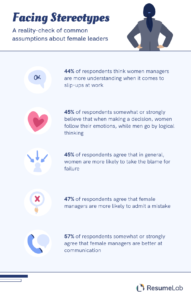A recent study by ResumeLab has found that of 800 employees surveyed in the US, close to four in 10 (38%) would prefer to work for a woman boss, followed by 26% who would prefer to work for a man; while 35% had no preference.May 14, 2021 There are numerous studies and articles about the stereotypes and perceptions. What are your thoughts?
With a greater focus on inclusion and equity we are making progress albeit slowly; why? We have all heard the comparisons. Men are assertive, women are aggressive; they can’t negotiate they are too emotional and let’s not get into the “monthly” issues.
The CEO of Better.com fired 900 people on Zoom. Nobody related his actions to his gender or race. Now imagine if a woman had done that and if it was a woman of color.
Another issue is in sales and marketing perceptions. According to the authors of Brandsplaining; Why Marketing Is (Still) Sexist and How to Fix It, marketing needs to look at women in terms of what they want and need not as they relate to men and how men see them. women aren’t just one group any more than men are. They have differing aspirations, strengths and abilities. An example i remember is buying a car. Women make 80% of the decisions on a car whether it’s for themselves their partners or their family yet ads and car dealers continuously talk down to or ignore women.
In today’s focus on diversity, equity inclusion and authenticity, many companies say they are hiring more women and more people of color in general, but at what level? Good news is the number of diverse women appointed to public boards has increased. in December 2020 107 women were appointed to boards of public companies vs. 175 men. women now comprise 41% of appointees. Why there and not in other arenas? How do the boards of private companies compare?
Why is this so important? Smart companies, both public and private are recognizing that growth and sustainability in the market need diversity of thought and ideas. As Einstein said, ” We cannot solve our problems with the same thinking that created them.” We need to expand our mindset and that can only be done by encouraging more diverse groups to help run and start companies. Giving women career paths that enable them to have access to resources, information, and skills is a first step. Enabling women to use their strengths improves performance on many levels. Providing opportunities to explore new ideas is key.
Much of this begins in schools especially those offering STEM ( Science , Technology, Engineering and Mathematics)( Also STEAM which adds art) At its very core, STEM is about a child’s ability to make meaningful connections between school, community, and global issues.
Remember when you used to ask yourself in high school, “How much of this stuff am I really going to use in the real world?” When STEM is taught effectively, it eliminates the need for that internal debate. Learning comes alive, is interactive, relevant, meaningful, and ultimately leads to very productive and rewarding careers in engineering, physical and life sciences, technology, and beyond.
With STEM job opportunities growing at a faster pace than non-STEM jobs, stereotypes that math is boring or that engineering is a “boy” thing are hurting our smart girls. Contrary to the widely accepted social bias that boys are more naturally capable of succeeding in math and science, research has shown that there is actually no difference in ability between both genders when it comes to math and science. However, girls are more prone to doubt their ability in STEM subjects, while boys believe they can learn and improve. Again we see the perceptions that have been fostered over the years.
Environmental factors, such as the level of exposure to STEM concepts, mentorship, and hands on project experiences are the most effective opportunities to make girls confident about STEM. These are ways to develop the CEOs, leaders, entrepreneurs and high performing individuals of the future.
Recent Comments